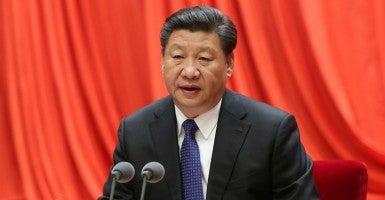Chinese President Xi Jinping has announced a massive overhaul in the organization of the Chinese People’s Liberation Army (PLA) headquarters structure. This comes after the announcement that three new services will be created (Ground Force, Rocket Force, and Strategic Support Force).
The PLA is different from the U.S. military in several major respects. First, it is not organized along service lines, and second is its function as part of the Chinese Communist Party.
The PLA operates under the administration of what is called the Central Military Commission, which is chaired by Xi and two uniformed vice chairmen (the most senior officers in the PLA).
Other members of the Central Military Commission include the heads of the “General Departments of the PLA”—the defense minister and the heads of the services.
Until this week, there were four General Departments, which had authority over the entire military. The various services were bureaucratically less important than the General Departments.
The four General Departments were:
- General Staff Department: war plans, military intelligence, some cyber activities
- General Political Department: political education and indoctrination, personnel issues, political warfare (public opinion warfare, legal warfare, psychological warfare), criminal investigations
- General Logistics Department: stocking beans, bullets, blankets, etc. for the entire military
- General Armaments Department: managing Chinese military development programs, including nuclear weapons, space facilities, weapons test ranges
This past week, China announced that the four general departments would now be replaced by fifteen departments, commissions, and offices.
There will be seven Departments of the Central Military Commission: general office, joint staff, political work, logistical support, equipment development, training, and national defense mobilization.
There will be three “Commissions of the Central Military Commission”: discipline inspection, politics and law, and science and technology.
There will also be five “Offices of the Central Military Commission”: strategic planning, administration, auditing, international cooperation, and organizational structure.
At this time, we do not yet have much insight into the specific tasks for many of these departments, commissions, and offices. For example, what is the division of labor between the Strategic Planning Office and the Joint Staff Department? What is the task of the Politics and Law Commission, and how does that relate to the Political Work Department? Where will intelligence activities reside?
Some insight may be gained from the anticipated third element of reform, which is expected to involve the military regions.
The Chinese military currently has seven military regions (junqu), which would be the basis for war zones (zhanqu) in wartime. The command structures of the military regions currently resemble miniature versions of the Central Military Commission, with military region counterparts to the General Staff Department, General Political Department, etc.
Whether, in the course of reform, the regional command entities, which succeed the military regions, will also have fifteen departments, commissions, and offices as well, and if not, which ones are missing, is likely to provide a clue as to how overall PLA organizational reform is being pursued.
At this point, we can only speculate as to why the Chinese decided to so massively expand the array of departments and commissions.
A larger bureaucracy is, in theory, more decentralized, and also more specialized, but it is also harder in such an organization to coordinate activities. It may be that this reorganization of the top headquarters is an effort to mollify the senior PLA leadership by ensuring that there is no shortage of general officer billets.
It may also be that this is a means for Xi to increase his support within the PLA, as all these new general officer billets will be filled with his people.































